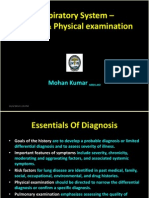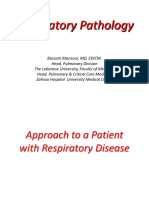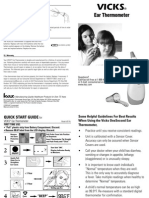Dyspnea Prof Menaldi Compressed
Dyspnea Prof Menaldi Compressed
Uploaded by
Ruki HartawanCopyright:
Available Formats
Dyspnea Prof Menaldi Compressed
Dyspnea Prof Menaldi Compressed
Uploaded by
Ruki HartawanOriginal Title
Copyright
Available Formats
Share this document
Did you find this document useful?
Is this content inappropriate?
Copyright:
Available Formats
Dyspnea Prof Menaldi Compressed
Dyspnea Prof Menaldi Compressed
Uploaded by
Ruki HartawanCopyright:
Available Formats
DYSPNEA
Menaldi Rasmin
Department of Pulmonology and Respiratory Medicine,
Faculty of Medicine, University of Indonesia
Persahabatan Hospital, Jakarta
Diagnosis
Dyspnea:
Discomfort feeling in breathing
Subjective and difficult to measure
Etiology : lung, heart, endocrine, kidney,
neurology, hematology, rheumatology and
psichology
Prevalence of dyspnea no accurate data
INTRODUCTION
1
Diagnosis
VENTILATORY REGULATION
located in the medulla of the brainstem
composed of several subcenters, that interact to
produce rhytmical breathing
output is transmitted to phrenic nerves to diaphragm
and respiratory muscles
affected by
Higher cortical centers
Mechanical
Chemical stimuli
Ventilatory Central Centre
Diagnosis
Cortical Centers
input to the ventilatory center
result; breathing partially under voluntary control
Mechanical reflexes
emanate from skeletal muscle spindle
pulmonary vessels and tissue
Diagnosis
Dyspnea
breathlessness
shortness of breath
uncomfortable or unpleasant
respiratory-related sensation
not tachypnea, not hyperpnea and not hyperventilation
but; difficult, labored, uncomfortable breathing; it is
unpleasant type of breathing though not painful in the
usual sense of the word.
It is subjective and, like pain, it involves both perception
of the sensation by the patient and his reaction to the
sensation
Comroe (1966)
Diagnosis
an uncomfortable awareness of breathing
or an increased respiratory effort that is
unpleasant and regarded as in appropriate
(Mahler et al 1984)
DEFINITION OF DYSPNEA
The American Thoracic Society (ATS):
the term of discomfort perception subjective in
breathing that consist of sensation with different
intensity as a results of interaction of various
physiologic, social and environtmental factors.
3
Diagnosis
MECHANISM OF DYSPNEA
Interaction between signal and
receptor in otonomic nerve
system, motoric cortex,airway
receptor, lung and thoracic cage
dyspnea
4
Diagnosis
MECHANISM OF DYSPNEA
Dispnea
Komplek pernapasan
Paru & dinding dada
kognitif
perilaku
Emosi
Stimulasi
kemoreseptor
latihan
Kortek motorik primer
Kortek sensorik primer
Dyspnea
Complex of breathing
Lung and thoracic cage
Cognitive
Behavior
Emotion
Chemoreceptor
stimulation
Exercise
Primary motoric cortex
Primary sensoric corte
Diagnosis
MECHANISM OF DYSPNEA
Diagnosis
Diagnosis
Diagnosis
Diagnosis
MEASUREMENT OF DYSPNEA
Aim : to differentiate the severity and to
evaluate the nature of dyspnea
Technique of measurement :
visual analogue scale
Borg scale
Medical Research Council (MRC) Dyspnea
Scale
American Thoracic Sosiety (ATS) Dyspnea
Scale
Baseline Dyspnea Index (BDI)
Transitional Dyspnea Index (TDI)
Diagnosis
ATS dyspnea index
Grade 1 : No dyspnea except severe
exercise activity
Grade 2 : Dyspnea when climb the step
in hurry or climb a small hill
Grade 3 : Walk slower compared to
common people
Grade 4 : Must stop for breathing after
100 yard walk
Grade 5 : Dyspnea while put on / off
the clothes
Dyspnea
pulmonary non-pulmonary
(cardiac)
*pulm edema *arrhythmias
*asthma/COPD *acute MI
*PE *myocardial ischemia
*pneumonia
*pneumothorax
DYSPNEA IN PULMONARY
DISEASE
Abnormality of breathing mechanism,
lung become more stiff, weakness of
ventilation muscles.
Restrictive lung diseases.
Obstructive lung diseases.
Disturbance of lung diffusion.
Disturbance of lung perfusion.
RESTRICTIVE LUNG DISEASE
Lung : - atelectasis
- fibrosis
- lung tumour
- bullae
- lung abscess
Mediastinum : - mediastinal tumour
- cardiomegali
- pericardial effusion
Diagnosis
ATELECTASIS
Diagnosis
PANCOAST TUMOR
Diagnosis
LUNG ABSCESS
Diagnosis
Diagnosis
DESTROYED LUNG
Diagnosis
BULLAE
Diagnosis
BULLAE
RESTRICTIVE LUNG DISEASE
Pleura : - pleural effusion
- pleural tumour
- pneumothorax
Diaphragm : - hernia of diaphragm
- paralize of diaphragm
Bone : - rib fracture
- pectus excavatum
- scoliosis, kyphosis
Muscle : - myasthenia gravis
Diagnosis
PLEURAL EFUSSION
Diagnosis
PNEUMOTHORAX
Diagnosis
HYDROPNEUMOTHORAX
OBSTRUCTIVE LUNG DISEASE
Asthma
COPD : - Chronic bronchitis
- Emphysema
Bronchiectasis
Lung tumour
Foreign body
Diagnosis
BRONCHIECTASIS
Diagnosis
LUNG TUMOR
DISTURBANCE OF DIFFUSION
Alveolar wall
Interstitial space
Arterial wall
Plasma
Red blood cell wall
Diagnosis
PNEUMONIA
Diagnosis
ARDS
DISTURBANCE OF
PERFUSSION
Pulmonary emboli
Congestive heart failure
Diagnosis
LUNG NODULES
Diagnosis
MILLIARY TB
Diagnosis
Diagnosis
Diagnosis
Diagnosis
CONCLUSION
Dyspnea is a subjective symptom
Various abnormalities may cause
dyspnea
Severity of dyspnea can be measured
Diagnosis
Diagnosis
Diagnosis
Diagnosis
You might also like
- ACCREDITATIONDocument62 pagesACCREDITATIONMargeYagoJulianoNo ratings yet
- Atlas of Critical CareDocument665 pagesAtlas of Critical CareOğuz Kayıkçı100% (5)
- JACKLER Brackmann NeurotologyDocument1,404 pagesJACKLER Brackmann NeurotologyRodrigo CabreraNo ratings yet
- W1. Pendekatan Sesak Pada AnakDocument32 pagesW1. Pendekatan Sesak Pada Anaksekrekomdik RSPDNo ratings yet
- Giving Direction in Hospital PDFDocument5 pagesGiving Direction in Hospital PDFAnisa Rizky Aulia100% (1)
- Basic Surgical Skills 2014Document108 pagesBasic Surgical Skills 2014Mi Zulfahmi Sha'ari100% (1)
- Gonstead Chiropractic MethodsDocument3 pagesGonstead Chiropractic MethodsJennifer0% (1)
- Interpretation of Arterial Blood Gases (ABGs)Document6 pagesInterpretation of Arterial Blood Gases (ABGs)afalfitra100% (1)
- Legmed Notes Yulo Outline PDFDocument76 pagesLegmed Notes Yulo Outline PDFCornelio Alfonso100% (1)
- Dyspnea - DR AllenDocument50 pagesDyspnea - DR AllenalmiraerickaiNo ratings yet
- DYSPNEADocument37 pagesDYSPNEAdr. snehal patilNo ratings yet
- Approach To DyspneaDocument60 pagesApproach To DyspneameritNo ratings yet
- Emergency Medicine Fourth Problem: Group 09 Tuesday, October 15, 2019Document47 pagesEmergency Medicine Fourth Problem: Group 09 Tuesday, October 15, 2019waraney palitNo ratings yet
- Dyspneabyahammednaseem 210628024048Document19 pagesDyspneabyahammednaseem 210628024048Naseem Bin YoosafNo ratings yet
- Cardiorespiratory Assessment: Dr. Amber Jamaal PTDocument94 pagesCardiorespiratory Assessment: Dr. Amber Jamaal PTAmber JamaalNo ratings yet
- Kuliah Pakar 2 Dyspnea PBLDocument35 pagesKuliah Pakar 2 Dyspnea PBLTrisya AksaraNo ratings yet
- BreathlessnessDocument29 pagesBreathlessnessRajveerNo ratings yet
- Dyspnea: Ahammed Naseem Roll No: 3 Second Year BSC Nursing Al-Mas College of NursingDocument19 pagesDyspnea: Ahammed Naseem Roll No: 3 Second Year BSC Nursing Al-Mas College of NursingNaseem Bin YoosafNo ratings yet
- Lec1 of Symptomatology of Chest DiseasesDocument26 pagesLec1 of Symptomatology of Chest Diseasesmenna hanyNo ratings yet
- Physical Examination Techniques and ManueversDocument160 pagesPhysical Examination Techniques and ManueversMa-anJaneDiamosNo ratings yet
- Assessing The Breathless PatientDocument34 pagesAssessing The Breathless PatientMithali GuptaNo ratings yet
- RespiratoryfailureDocument46 pagesRespiratoryfailurebm5rf7ph4qNo ratings yet
- Tiếp Cận Bệnh Hô Hấp-Th PhúDocument68 pagesTiếp Cận Bệnh Hô Hấp-Th PhúPhương AnhNo ratings yet
- Dyspnea (Medicine 2)Document11 pagesDyspnea (Medicine 2)Zoha AmjadNo ratings yet
- PneumoniaDocument28 pagesPneumoniaHoward SakalaNo ratings yet
- Assessment Pada Covid-19Document60 pagesAssessment Pada Covid-19FISIOTERAPI TRIMITRANo ratings yet
- Idiopathic Pulmonary FibrosisDocument52 pagesIdiopathic Pulmonary FibrosisOlga GoryachevaNo ratings yet
- Physical ExamDocument25 pagesPhysical Examlady birdNo ratings yet
- Lect 16 - Diseases of Respiratory SystemDocument43 pagesLect 16 - Diseases of Respiratory SystemDhanush VNo ratings yet
- Respiratory Medicine Dental 2018Document28 pagesRespiratory Medicine Dental 2018David McMahonNo ratings yet
- Cherian2019 PDFDocument23 pagesCherian2019 PDFnugra raturandangNo ratings yet
- Sleep ApneaDocument134 pagesSleep Apneakamal saud100% (1)
- Investigations - Respiratory System: Vd. Santhosh BDocument33 pagesInvestigations - Respiratory System: Vd. Santhosh Bsantosh S BNo ratings yet
- Restrictive Lung DiseasesDocument38 pagesRestrictive Lung Diseasesbuttmahnoor851No ratings yet
- Common and Uncommon Causes of Chronic CoughDocument51 pagesCommon and Uncommon Causes of Chronic CoughfouadNo ratings yet
- Respiratory System - History & Physical Examination: Mohan KumarDocument35 pagesRespiratory System - History & Physical Examination: Mohan KumaraagarwalmdNo ratings yet
- Dyspnea N Resp FailureDocument63 pagesDyspnea N Resp FailurerujhanraqibiNo ratings yet
- Dispne 2021Document46 pagesDispne 2021carringtoncorlineNo ratings yet
- Respiratory System: By: Dr. Ab Dullah Al-MulhimDocument18 pagesRespiratory System: By: Dr. Ab Dullah Al-Mulhimapi-3858544No ratings yet
- Restrictive Lung DiseaseDocument32 pagesRestrictive Lung DiseaseSalman Khan100% (1)
- C.O.P.D: (Chronic Obstructive Pulmonary Disorder)Document47 pagesC.O.P.D: (Chronic Obstructive Pulmonary Disorder)KrystelNo ratings yet
- Interpretation of Symptoms and Signs of Respiratory DiseasesDocument52 pagesInterpretation of Symptoms and Signs of Respiratory DiseasesAbdul JalilNo ratings yet
- DyspeneuDocument18 pagesDyspeneuFaerusNo ratings yet
- 4th Problem KGD DanielDocument130 pages4th Problem KGD DanielSelly HerliaNo ratings yet
- Assessment of The Respiratory SystemDocument49 pagesAssessment of The Respiratory SystemMilanisti22No ratings yet
- "Dyspnea: Mechanisms, Assessment & Management": Seminar OnDocument31 pages"Dyspnea: Mechanisms, Assessment & Management": Seminar OnPriya KuberanNo ratings yet
- NCM103 - 2016 - Lecture2 - Response To Altered Respiratory FunctionDocument128 pagesNCM103 - 2016 - Lecture2 - Response To Altered Respiratory FunctionrimeoznekNo ratings yet
- A Grand Tour of Pulmonary MedicineDocument115 pagesA Grand Tour of Pulmonary MedicineKaram SarhanNo ratings yet
- Respiratory System History Taking: Dr. Aiman Al ShareiDocument20 pagesRespiratory System History Taking: Dr. Aiman Al ShareiQusai IbraheemNo ratings yet
- K14 - Sesak Dan Pneumonia Pada AnakDocument125 pagesK14 - Sesak Dan Pneumonia Pada AnakBintang FortunaNo ratings yet
- Fourth Problem: Group 3 Emergency Medicine Block 2018 Alvin RinaldoDocument93 pagesFourth Problem: Group 3 Emergency Medicine Block 2018 Alvin RinaldoSelly HerliaNo ratings yet
- Respiratory System Assessment PDFDocument53 pagesRespiratory System Assessment PDFJay RomeNo ratings yet
- Respiratory System Hist ExamDocument43 pagesRespiratory System Hist Examgenaong2003No ratings yet
- Sleep Medicine: Devi Farida UtamiDocument105 pagesSleep Medicine: Devi Farida UtamimufiNo ratings yet
- Assessment of Respiratory Function: K SuardanaDocument30 pagesAssessment of Respiratory Function: K SuardanaMeilia DewiiNo ratings yet
- DyspneaDocument34 pagesDyspneagiogoriNo ratings yet
- Group 1 6 Problem Emergency Medicine Block Monday, 30 Oct 2017Document121 pagesGroup 1 6 Problem Emergency Medicine Block Monday, 30 Oct 2017Jonathan TandajuNo ratings yet
- Evaluation of The Patient With Pulmonary DiseaseDocument57 pagesEvaluation of The Patient With Pulmonary DiseaseJr SparkNo ratings yet
- Respiratory Emergencies2Document47 pagesRespiratory Emergencies2yeniNo ratings yet
- Respiratory Disorders: Dr. Fajar Wahyu PribadiDocument66 pagesRespiratory Disorders: Dr. Fajar Wahyu PribadiwinarsohNo ratings yet
- Nursing Management of Patient With Respiratory ProblemsDocument151 pagesNursing Management of Patient With Respiratory ProblemsAbirajan100% (3)
- Assessment Cardiovascular Sy - 1Document32 pagesAssessment Cardiovascular Sy - 1TASNEEM LAKKADSHANo ratings yet
- 01 Approach To A Patient With Respiratory Disease (Mansour)Document33 pages01 Approach To A Patient With Respiratory Disease (Mansour)Ahmad TwenyNo ratings yet
- Acute Respiratory FailureDocument51 pagesAcute Respiratory Failureigorhorenko15No ratings yet
- Sherif EL Hawary, MD Professor of Internal Medicine Kasr AL AiniDocument35 pagesSherif EL Hawary, MD Professor of Internal Medicine Kasr AL Aini670411No ratings yet
- Postgraduate Course 3 Radiological-Pathological Correlation of Tumoural and Non-Tumoural Pathology: An Interdisciplinary ApproachDocument31 pagesPostgraduate Course 3 Radiological-Pathological Correlation of Tumoural and Non-Tumoural Pathology: An Interdisciplinary ApproachBulborea MihaelaNo ratings yet
- Respiratory Emergencies: or All That Wheezes Is NOT AsthmaDocument47 pagesRespiratory Emergencies: or All That Wheezes Is NOT AsthmaAnityo NugrohoNo ratings yet
- Diaphragm Diseases, A Simple Guide To The Condition, Diagnosis, Treatment And Related ConditionsFrom EverandDiaphragm Diseases, A Simple Guide To The Condition, Diagnosis, Treatment And Related ConditionsNo ratings yet
- DR Yudi The Importance of Targeting Plaque Regression in Dyslipidemia Management Copy DikonversiDocument37 pagesDR Yudi The Importance of Targeting Plaque Regression in Dyslipidemia Management Copy DikonversiRuki HartawanNo ratings yet
- Dr. Achmad Lefi Understanding The Needs of The High Productive Dyslipidemia Patients Case Study ApproachDocument53 pagesDr. Achmad Lefi Understanding The Needs of The High Productive Dyslipidemia Patients Case Study ApproachRuki HartawanNo ratings yet
- Coagulopathy in Patient With Covid19Document27 pagesCoagulopathy in Patient With Covid19Ruki HartawanNo ratings yet
- Pet Spect MRCCC Siloam Semanggi 26mei2012Document49 pagesPet Spect MRCCC Siloam Semanggi 26mei2012Ruki HartawanNo ratings yet
- Ards PDFDocument20 pagesArds PDFRuki HartawanNo ratings yet
- Presentation VentiDocument41 pagesPresentation VentiRuki HartawanNo ratings yet
- DR - Dedi Alita Why Do We Need de ResuscitationDocument31 pagesDR - Dedi Alita Why Do We Need de ResuscitationRuki HartawanNo ratings yet
- Herbal DR Nyoman SP PDDocument27 pagesHerbal DR Nyoman SP PDRuki HartawanNo ratings yet
- Cranial Neuralgia Keynote PDFDocument21 pagesCranial Neuralgia Keynote PDFRuki HartawanNo ratings yet
- Persistent Asthma - Prof DR SidhartaniDocument18 pagesPersistent Asthma - Prof DR SidhartaniRuki HartawanNo ratings yet
- Buku Bedah UmumDocument126 pagesBuku Bedah UmumSilvia Kamal100% (7)
- Hand Book Gastro Ardy MoeftyDocument57 pagesHand Book Gastro Ardy MoeftyRuki HartawanNo ratings yet
- DI-Imaging of Head Traum 2009 (TN)Document82 pagesDI-Imaging of Head Traum 2009 (TN)Ruki HartawanNo ratings yet
- Persistent Asthma - Prof DR SidhartaniDocument18 pagesPersistent Asthma - Prof DR SidhartaniRuki HartawanNo ratings yet
- Cases Files NeuroDocument214 pagesCases Files Neurovgdfhgdfg100% (1)
- 2016 S 0042 108641 PDFDocument29 pages2016 S 0042 108641 PDFMadalina StoicescuNo ratings yet
- Case Study: BronchiectasisDocument5 pagesCase Study: BronchiectasisHanna Mae HernandezNo ratings yet
- Ashley Fagert ResumeDocument1 pageAshley Fagert Resumeapi-455767165No ratings yet
- Stabilizing Teeth With Non Surgical Treatment: A Case Report of SplintingDocument3 pagesStabilizing Teeth With Non Surgical Treatment: A Case Report of SplintingAgum Nila Sari IINo ratings yet
- Activities in The Corporate RetreatDocument6 pagesActivities in The Corporate RetreatMarie Abigail LapinidNo ratings yet
- Final 2016 ResumeDocument4 pagesFinal 2016 Resumeapi-311457885No ratings yet
- Neurology Case ConferenceDocument64 pagesNeurology Case ConferenceAnonymous HH3c17osNo ratings yet
- INTRODUCTIONDocument3 pagesINTRODUCTIONSoumya Suguna TripathyNo ratings yet
- Kyoto Kagaku - Eye Examination SimulatorDocument2 pagesKyoto Kagaku - Eye Examination SimulatorGabriela Zavaleta Camacho100% (1)
- Estenosis Hipertrófica de PiloroDocument1 pageEstenosis Hipertrófica de PiloroJoaquín SosaNo ratings yet
- Vicks Thermometer v971nDocument6 pagesVicks Thermometer v971nCesar FloresNo ratings yet
- Lauren Bradley ResumeDocument1 pageLauren Bradley Resumeapi-403271636No ratings yet
- Atrial Septal DefectDocument3 pagesAtrial Septal Defectktin17No ratings yet
- Pune Doctor List - 5Document12 pagesPune Doctor List - 5sadiq shaikhNo ratings yet
- Breech Presentation and DeliveryDocument7 pagesBreech Presentation and DeliverySteven Herbert0% (1)
- Management of Acute MI, Role of Streptokinase, NicvdDocument22 pagesManagement of Acute MI, Role of Streptokinase, NicvdNavojit ChowdhuryNo ratings yet
- DirectoryDocument92 pagesDirectoryAlejandro VelazquezNo ratings yet
- PolyhydramniosDocument2 pagesPolyhydramniosAde Yonata100% (1)
- Songs NewDocument16 pagesSongs NewEdmonLagarto100% (1)
- Fragile X SyndromeDocument11 pagesFragile X SyndromeMartin100% (1)
- Best Polyclinic in CherpuDocument5 pagesBest Polyclinic in Cherpusmv09953No ratings yet






































































































